Why you can trust Tom's Hardware
We were mightily impressed with the MAG274QRF-QD’s grayscale, gamma and color performance. Not only does it deliver the largest color gamut we’ve measured, it boasts some of the best out-of-box accuracy as well.
Grayscale and Gamma Tracking
Our grayscale and gamma tests use Calman calibration software from Portrait Displays. We describe those tests in detail here.
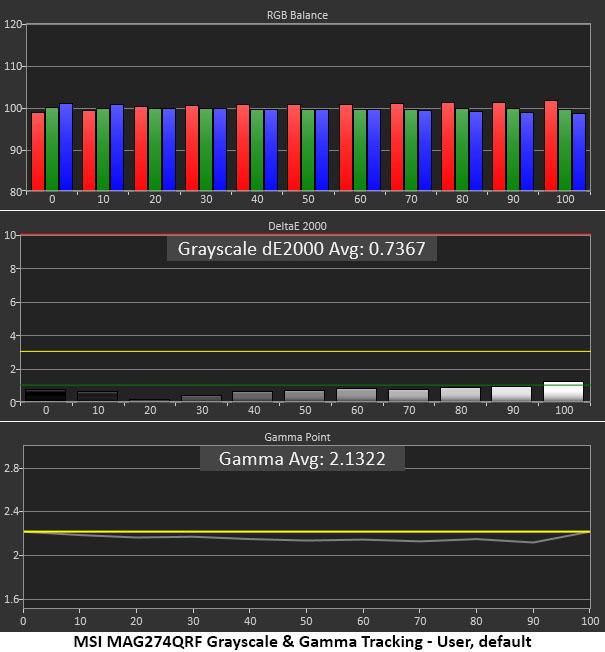
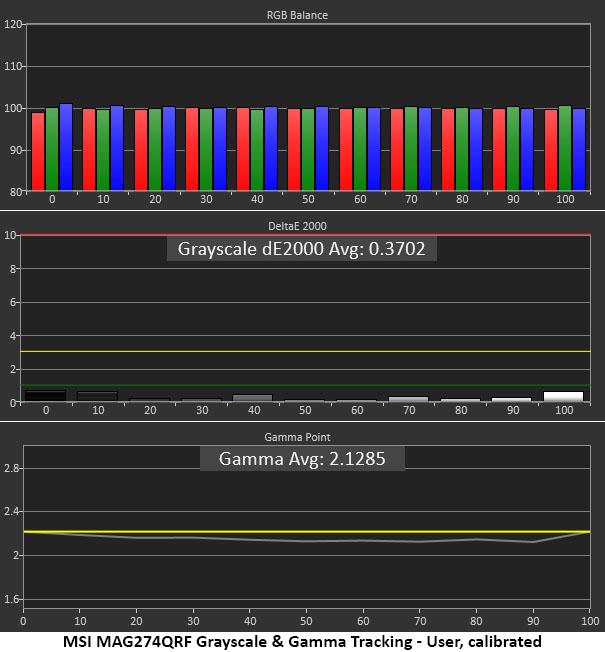
Looking at the first grayscale chart, it’s clear there is no need for calibration. There are no visible grayscale errors whatsoever with only the 100% brightness step exceeding an error of 1 Delta E (dE). That’s professional-grade accuracy. Gamma is a tad light with a 2.13 average, but in actual usage that wasn’t a visible issue. Gamma tracking is true with no deviations to speak of.
Calibration improves the DeltaE number a bit, but there is no visual benefit to adjustment.
Comparisons
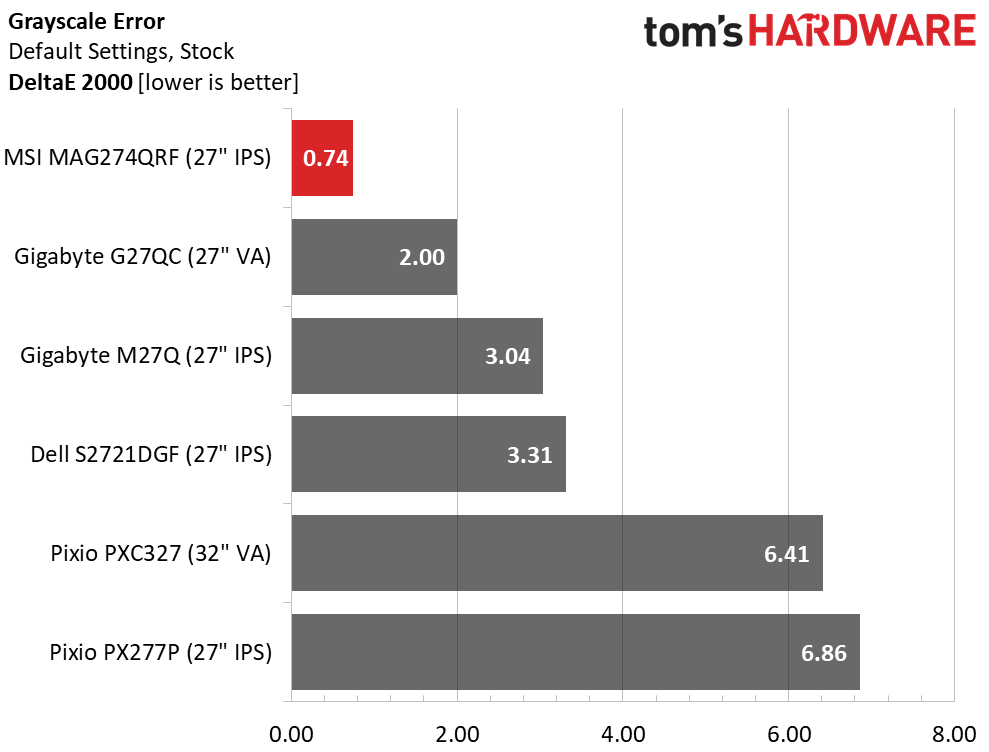
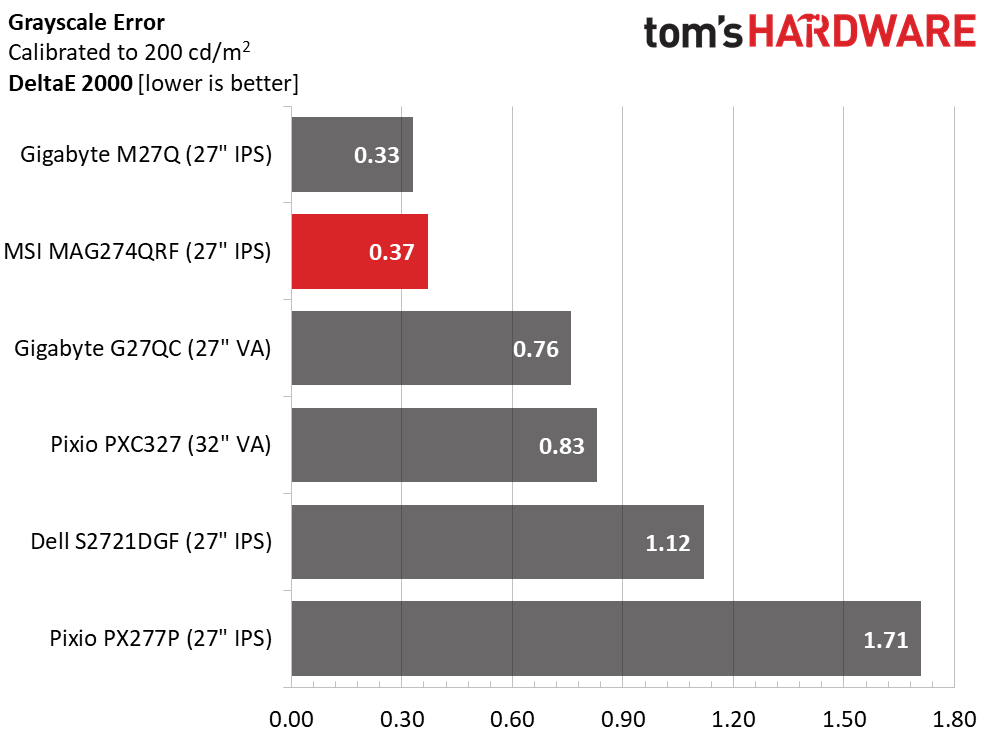
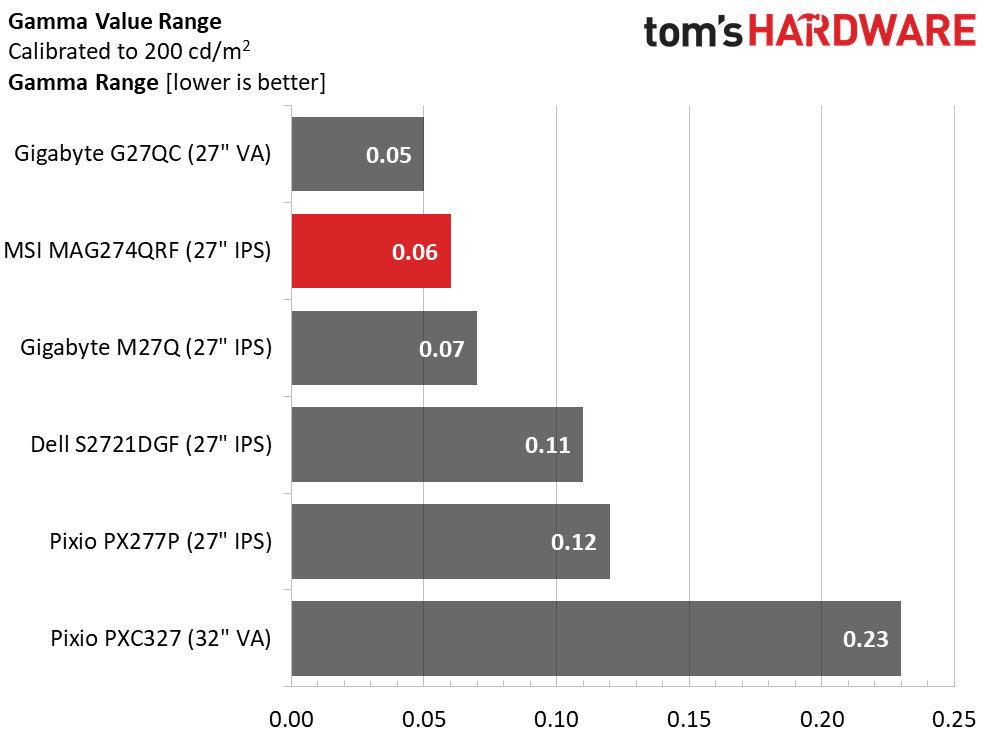
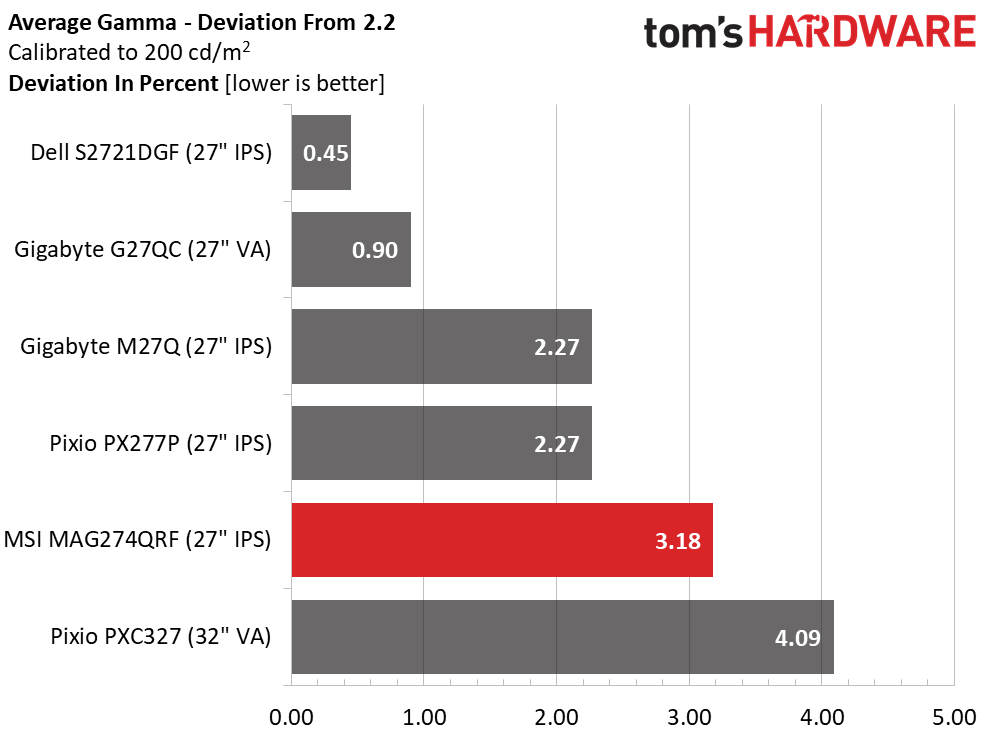
There isn’t much to say here besides, wow! A 0.74dE default grayscale measurement is among the best we’ve ever recorded for any monitor. A calibrated value of 0.37 is also one of the lowest in our database. The MAG274QRF-QD’s grayscale performance is superb.
Gamma tracking is also very tight with just 0.06 separating the highest and lowest values. The curve is a tad light with a 3.18% deviation (2.13 value) but this does not detract from the super-saturated color we observed. If we’re being picky, we’d ask for a few gamma presets so we could select a slightly darker option.
Color Gamut Accuracy
Our color gamut and volume testing uses Portrait Displays’ Calman software. For details on our color gamut testing and volume calculations, click here.
Get Tom's Hardware's best news and in-depth reviews, straight to your inbox.

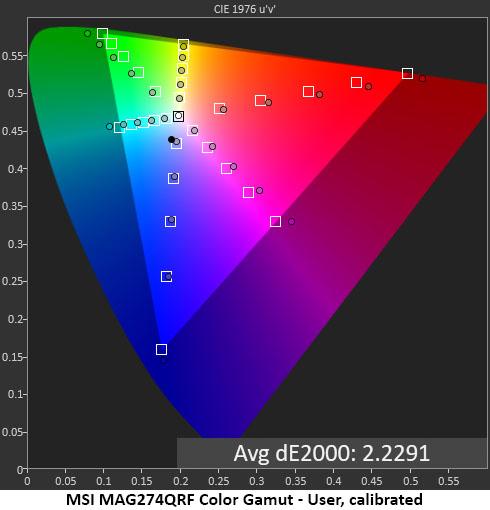
Here is the star of the MAG274QRF-QD’s show: its large color gamut. We’ve created our charts using the DCI-P3 reference and you can see that all three primaries exceed the triangle’s perimeter. Green, red and magenta are slightly off in hue, but those errors were not visible in content. Saturation targets track linearly, so there was no clipping of detail either.
Content created in smaller gamuts like sRGB will look very saturated, but by and large, the MSI’s image is just really colorful. HDR content looks great with these added hues, even though HDR contrast is not tremendous.
The second chart shows calibration doesn’t change the result much. In fact, the average error is a tad higher, though still well below the threshold of visibility. This is excellent performance.
Comparisons

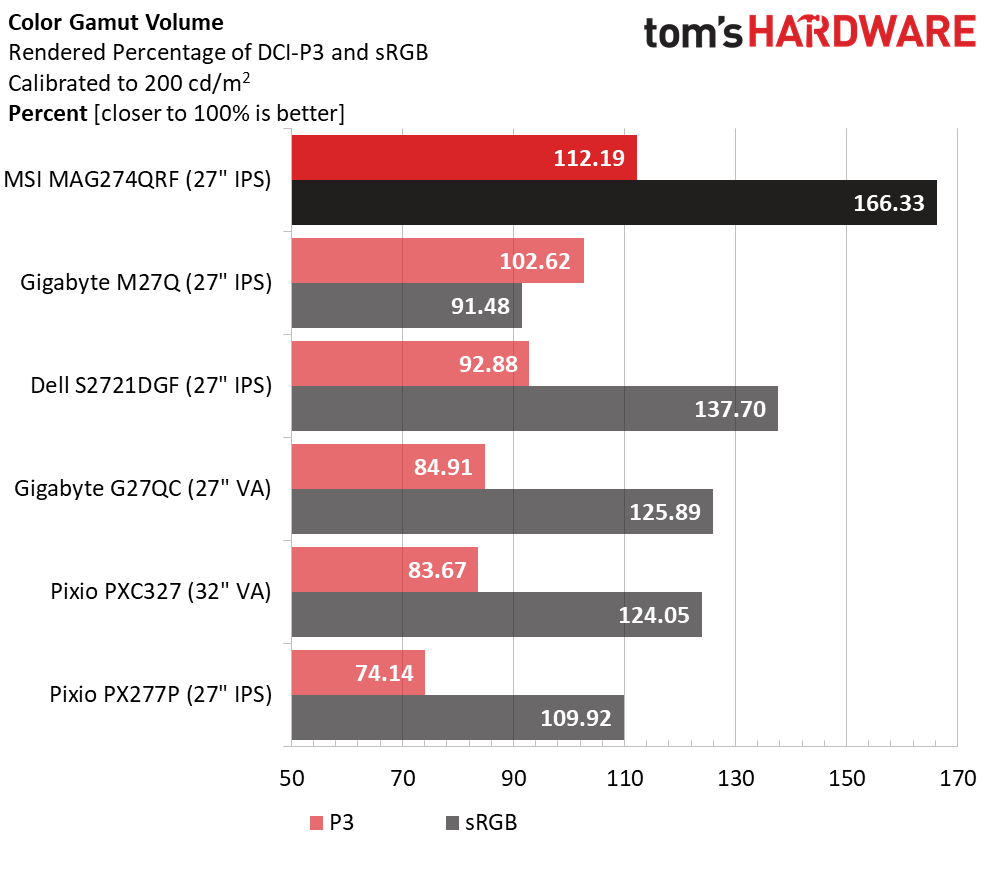
With a final average gamut error of 2.23dE, the MAG274QRF-QD is one of the better monitors we’ve tested but amazingly only manages fifth place in this group. That speaks volumes about the quality of today’s gaming monitors. You don’t need to buy a high-end screen to get accurate color. Even the value-priced Pixio PXC327 manages a low score of just 1.65dE.
Here is the graph everyone will be talking about. The MAG274QRF-QD has the largest color gamut we’ve ever measured. With 112.19% coverage of DCI-P3, it will look vibrant and saturated all the time. And we mean all the time. sRGB coverage is a staggering 166.33%. That’s because there is no sRGB mode available. That might be an issue for color purists; any color-critical work will require the use of a software profile.
Current page: Grayscale, Gamma and Color
Prev Page Brightness and Contrast Next Page HDR Performance
Christian Eberle is a Contributing Editor for Tom's Hardware US. He's a veteran reviewer of A/V equipment, specializing in monitors. Christian began his obsession with tech when he built his first PC in 1991, a 286 running DOS 3.0 at a blazing 12MHz. In 2006, he undertook training from the Imaging Science Foundation in video calibration and testing and thus started a passion for precise imaging that persists to this day. He is also a professional musician with a degree from the New England Conservatory as a classical bassoonist which he used to good effect as a performer with the West Point Army Band from 1987 to 2013. He enjoys watching movies and listening to high-end audio in his custom-built home theater and can be seen riding trails near his home on a race-ready ICE VTX recumbent trike. Christian enjoys the endless summer in Florida where he lives with his wife and Chihuahua and plays with orchestras around the state.
-
JoBalz ReplyKridian said:$562!? (NewEgg)
muaaahahahahahaaaaa!
I was just looking at other gaming monitors that use Quantum Dot technology displays. This one is one of the least expensive listed as using this tech. -
samopitam Is standard calibration using something like Xrite i1display calibrator enough to decrease the oversaturation and gamma of this monitor to a normal, more natural level while still covering a big percentage of the AdobeRGB gamut?Reply
When using such a calibrator (using either its own or displayCAL software) will every program then automatically use the new lower saturation level? I have no experience with calibration devices so I am just worried about color accuracy and the stated problem that colors will be oversaturated and therefore false all the time. This monitor will be used with both Mac and PC for print and web design. I'm not sure if this software just creates an ICC profile that you can choose system-wide in OS and then change easily to an ICC with more saturation, or if it does something more.
I'm interested in natural saturation levels until a project comes when I will have the need to see more of the color gamut in a graphics program. Is then all that is necessary to choose an AdobeRGB ICC profile in a graphics program like Adobe to view more colors or will the monitor calibration that lowered the saturation prevent you from ever seeing those colors unless you recalibrate? -
Maverick110 Does the Optix MAG274QRF-QD have a DisplayPort 1.2a port or a DisplayPort 1.4? The MSI product specifications page has a DP1.2a. The MSI store page specification section has DP1.4. It's just a bit confusing.Reply